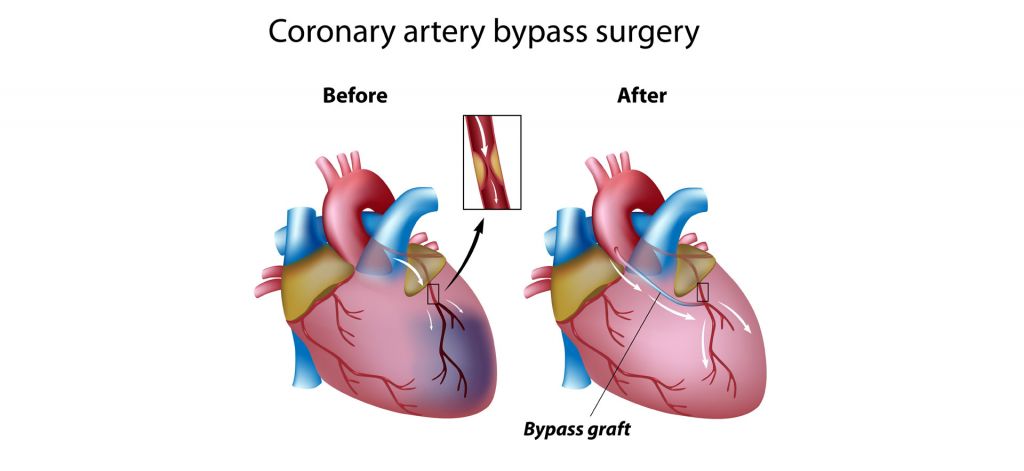DIAGNOSES-OPERATIONS
CORONARY ARTERY DISEASE – BYPASS OPERATION
WHAT IS IT?
The coronary arteries supply blood with oxygen to the muscle of the heart. When there is a narrowing of one of these blood vessels that does not allow sufficient blood to reach the heart muscle it is called coronary artery disease.
WHAT ARE THE CAUSES?
There are multiple factors that contribute to cause narrowing and blockage of the blood flow to the heart. Amongst these are high blood pressure (hypertension), smoking, elevated cholesterol levels and diabetes.
SYMPTOMS
The main symptom of coronary artery disease is pain in the chest that usually comes during physical activity. In certain groups of people such as women and diabetics there may be a lack of the typical symptoms and instead a feeling of dizziness, nausea, heaviness of the chest or difficulty breathing.
CONSEQUENCES
If coronary artery disease is not treated properly this may lead to a myocardial infarction (heart attack) which means that a large portion of the heart muscle may die and the heart will have difficulty pumping blood.
OPERATION
Coronary artery disease can be dealt with using stents or coronary bypass surgery. Bypass surgery is preferred in cases of multiple vessel disease or in narrowing of the main artery (left main coronary artery) of the heart. Also, diabetic patients benefit more from coronary bypass surgery than from stenting due to the fact that they usually have diffuse disease in their blood vessels (as opposed to a focal narrowing that can be treated with a stent). For the actual bypass graft other blood vessels (arteries and veins) are used. The surgeon can select amongst the following for use as a bypass graft: left internal mammary (also known as internal thoracic) artery, right internal mammary artery, radial artery, saphenous vein. The use of arterial grafts is preferred but for technical reasons they can only be used in cases of very high-grade blockage. The second choice the surgeon makes in a bypass operation is whether to perform the operation “on-pump” (using extracorporeal circulation) or “off-pump” on a beating heart. Recent studies show worse long-term results when the beating heart method is used for patients with multiple blockages. For this reason beating heart coronary bypass is now mainly used for patients who cannot undergo the usual procedure due to technical reasons (porcelain aorta, for example).
The coronary arteries supply blood with oxygen to the muscle of the heart. When there is a narrowing of one of these blood vessels that does not allow sufficient blood to reach the heart muscle it is called coronary artery disease.
WHAT ARE THE CAUSES?
There are multiple factors that contribute to cause narrowing and blockage of the blood flow to the heart. Amongst these are high blood pressure (hypertension), smoking, elevated cholesterol levels and diabetes.
SYMPTOMS
The main symptom of coronary artery disease is pain in the chest that usually comes during physical activity. In certain groups of people such as women and diabetics there may be a lack of the typical symptoms and instead a feeling of dizziness, nausea, heaviness of the chest or difficulty breathing.
CONSEQUENCES
If coronary artery disease is not treated properly this may lead to a myocardial infarction (heart attack) which means that a large portion of the heart muscle may die and the heart will have difficulty pumping blood.
OPERATION
Coronary artery disease can be dealt with using stents or coronary bypass surgery. Bypass surgery is preferred in cases of multiple vessel disease or in narrowing of the main artery (left main coronary artery) of the heart. Also, diabetic patients benefit more from coronary bypass surgery than from stenting due to the fact that they usually have diffuse disease in their blood vessels (as opposed to a focal narrowing that can be treated with a stent). For the actual bypass graft other blood vessels (arteries and veins) are used. The surgeon can select amongst the following for use as a bypass graft: left internal mammary (also known as internal thoracic) artery, right internal mammary artery, radial artery, saphenous vein. The use of arterial grafts is preferred but for technical reasons they can only be used in cases of very high-grade blockage. The second choice the surgeon makes in a bypass operation is whether to perform the operation “on-pump” (using extracorporeal circulation) or “off-pump” on a beating heart. Recent studies show worse long-term results when the beating heart method is used for patients with multiple blockages. For this reason beating heart coronary bypass is now mainly used for patients who cannot undergo the usual procedure due to technical reasons (porcelain aorta, for example).

